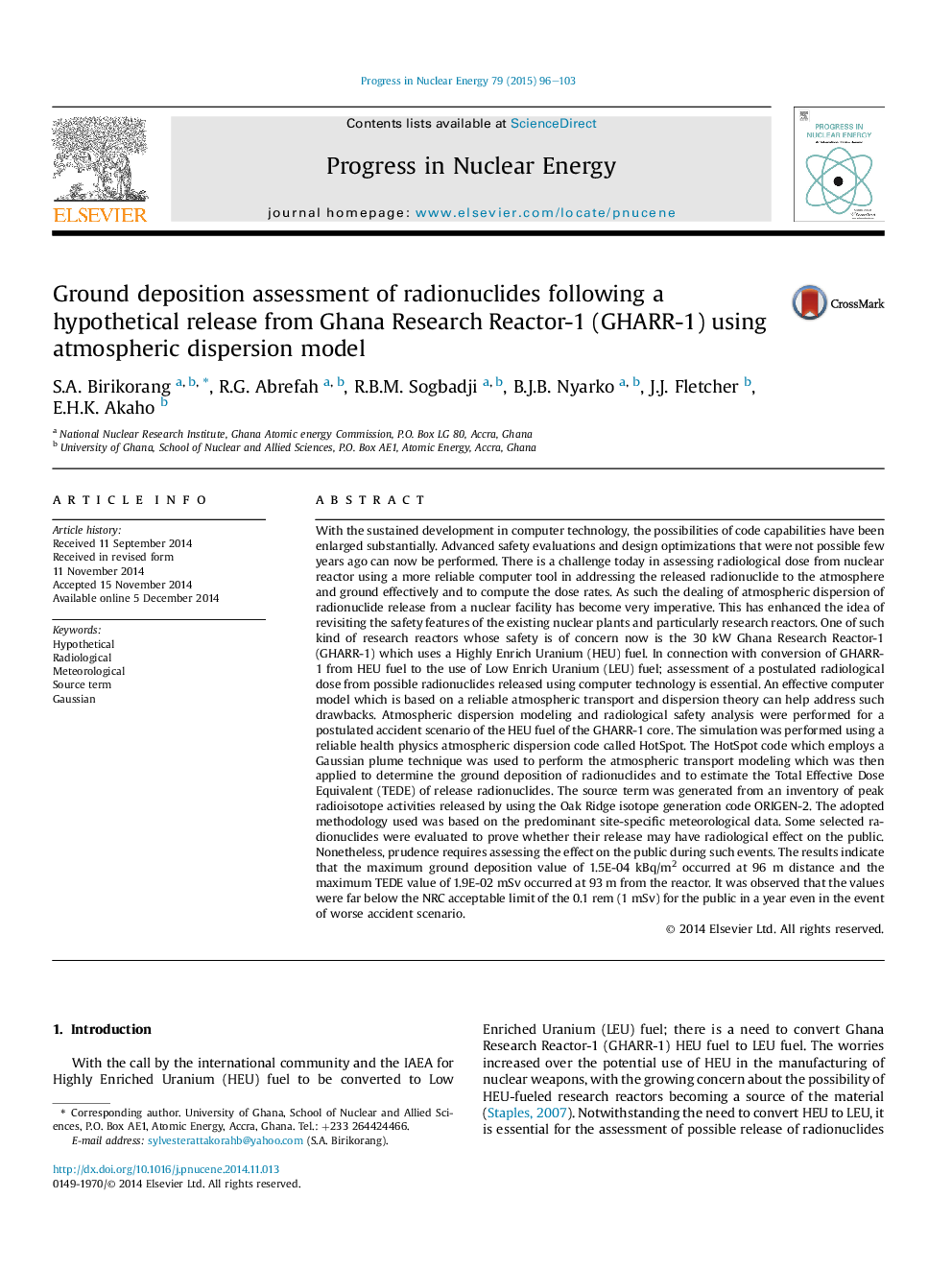| کد مقاله | کد نشریه | سال انتشار | مقاله انگلیسی | نسخه تمام متن |
|---|---|---|---|---|
| 8085530 | 1521759 | 2015 | 8 صفحه PDF | دانلود رایگان |
عنوان انگلیسی مقاله ISI
Ground deposition assessment of radionuclides following a hypothetical release from Ghana Research Reactor-1 (GHARR-1) using atmospheric dispersion model
دانلود مقاله + سفارش ترجمه
دانلود مقاله ISI انگلیسی
رایگان برای ایرانیان
کلمات کلیدی
موضوعات مرتبط
مهندسی و علوم پایه
مهندسی انرژی
مهندسی انرژی و فناوری های برق
پیش نمایش صفحه اول مقاله

چکیده انگلیسی
With the sustained development in computer technology, the possibilities of code capabilities have been enlarged substantially. Advanced safety evaluations and design optimizations that were not possible few years ago can now be performed. There is a challenge today in assessing radiological dose from nuclear reactor using a more reliable computer tool in addressing the released radionuclide to the atmosphere and ground effectively and to compute the dose rates. As such the dealing of atmospheric dispersion of radionuclide release from a nuclear facility has become very imperative. This has enhanced the idea of revisiting the safety features of the existing nuclear plants and particularly research reactors. One of such kind of research reactors whose safety is of concern now is the 30Â kW Ghana Research Reactor-1 (GHARR-1) which uses a Highly Enrich Uranium (HEU) fuel. In connection with conversion of GHARR-1 from HEU fuel to the use of Low Enrich Uranium (LEU) fuel; assessment of a postulated radiological dose from possible radionuclides released using computer technology is essential. An effective computer model which is based on a reliable atmospheric transport and dispersion theory can help address such drawbacks. Atmospheric dispersion modeling and radiological safety analysis were performed for a postulated accident scenario of the HEU fuel of the GHARR-1 core. The simulation was performed using a reliable health physics atmospheric dispersion code called HotSpot. The HotSpot code which employs a Gaussian plume technique was used to perform the atmospheric transport modeling which was then applied to determine the ground deposition of radionuclides and to estimate the Total Effective Dose Equivalent (TEDE) of release radionuclides. The source term was generated from an inventory of peak radioisotope activities released by using the Oak Ridge isotope generation code ORIGEN-2. The adopted methodology used was based on the predominant site-specific meteorological data. Some selected radionuclides were evaluated to prove whether their release may have radiological effect on the public. Nonetheless, prudence requires assessing the effect on the public during such events. The results indicate that the maximum ground deposition value of 1.5E-04Â kBq/m2 occurred at 96Â m distance and the maximum TEDE value of 1.9E-02Â mSv occurred at 93Â m from the reactor. It was observed that the values were far below the NRC acceptable limit of the 0.1Â rem (1Â mSv) for the public in a year even in the event of worse accident scenario.
ناشر
Database: Elsevier - ScienceDirect (ساینس دایرکت)
Journal: Progress in Nuclear Energy - Volume 79, March 2015, Pages 96-103
Journal: Progress in Nuclear Energy - Volume 79, March 2015, Pages 96-103
نویسندگان
S.A. Birikorang, R.G. Abrefah, R.B.M. Sogbadji, B.J.B. Nyarko, J.J. Fletcher, E.H.K. Akaho,